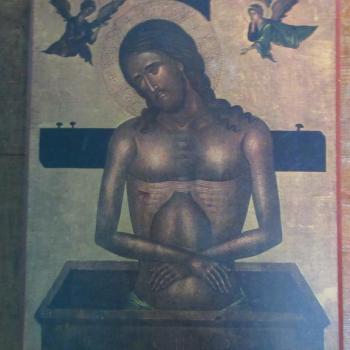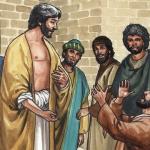From the life, death and resurrection of Jesus we go from the kingdom of heaven being at hand to the eschaton itself having become immanent. The world has experienced the end with the death of Christ; the eschaton has found its place in the world and its influence spreads throughout all time, bring all that is and was into its grasp. The early Christians recognized this; Paul called Jesus the New Adam, the first to be raised from the dead. They expected that the immanence of the eschaton meant the world itself would soon see and recognize its own end. The problem is, though the eschaton had become immanent, the world seemingly went on – Christians had to come to understand this, to understand eschatology differently so as to answer their critics as to why Jesus, the Apostles, and early believers were not wrong.
The solution of course is to understand the eschaton as being outside of time. It does not have to appear in time in the chronological, historical order which we might otherwise expect. All time flows into the eschaton, but also, the eschaton itself can be said to be rooted at fixed points in time, making sure time and eternity are bridged together and that time itself is not worthless. The eschaton even can make the relationship between events go in reverse of chronological order, so that latter events can be the source and foundation of earlier events; thus, the Lamb of God can be slain “from the foundation of the world” and the immaculate conception of the Theotokos can rely upon the work of her son, Christ, on the cross long after her conception to make sure she was conceived without sin.
The eschaton is found in the person of Christ, and the eschaton is rooted to history through theophany and incarnation, where the person of Christ (with the rest of the Trinity) is at work in history, making sure there is meaning behind history so that history is not just a meaningless flow of events, one from another. God, who is love, communicates himself through story, the story which is history, a story which transcends rationalistic historicism and is better thought of as a historical myth, or as an apocalyptic tale, where the events of history relate together to tell all of God’s audience a higher, transcendent truth. It is a truth which one could not find by themselves if God had not given himself to creation and infused it with meaning. Thus, events can point to one another, events in time can typify higher truths, and events in time can point to spiritual realities which lie underneath simplistic positivistic presentations of them.
This is best represented by the book of the Apocalypse. It is the book the most touched with an eschatological vision of history, and it is for this reason why it is the book most misunderstood. When the eschaton is not recognized to be seen in the work of Christ, then people try to decode the message of the Apocalypse with a false hermeneutic, leading to all kinds of errors in the process. There is nothing wrong in trying to see the work of the eschaton in the world today, since the eschaton is at work at all times, but it is wrong to look at the Apocalypse as a book of future history, following the rules of historical narration. A book which discusses the fall of Satan at the beginning of time and finds it connected to the birth of Christ at a latter point in time shows us that the eschatological vision cannot be said to be a chronology.
The center of the tale is Christ, and Christ on the cross. Oecumenius in his early commentary on the Apocalypse helps us understand this point. He shows, for example, how a vision in the Apocalypse relates to the eschaton made immanent in Christ. His rendition of the opening of the seals, for example, makes this clear. The opening of the first seal to him, with the rider on the white horse, represents the victory of the Gospel about to be had among the nations of the world.[1] The opening of the second, with the red sword, represents the work of Christ’s blood to conquer evil, to overcome the “propensity for evil found among the inhabitants of the earth.”[2] The third seal opens showing the miraculous ability of Christ: “The third mercy of Christ to us broke the third seal, and brought us from condemnation back to God the Father. This mercy is his saving teaching and the benefits effected through his divine miracles. For these contributed to the destruction of the Devil.”[3] Then, we are told, “The breaking of the fourth seal and the rest marks the beginning of release from sin resulting from Adam’s transgression.”[4] What about the rider on the pale horse? “The greenish horse is the symbol of wrath, for bile, as doctors call it, is greenish. Death and Hades were sent for the spiritual overthrow of the sinful demons and to exact retribution from them for the destruction of humankind.”[5] The fifth seal brings us to Christ’s passion. “So the fifth salvation of the Lord given to the human race, the one which broke the fifth seal of the Lord and effected the removal of our sins and the restoration of our intimacy with God, was found in the bonds and wounds with which the Lord was held when he was brought before Pilate, and which he suffered at the hands of Pilate himself who showed a half-hearted reverence.”[6] The sixth seal, with its earthquake, easily points to the cross: “What is the breaking of the sixth seal? The cross of the Lord and his death which were followed by the resurrection and ascension in response to the prayers of all spiritual and sensible creation, ‘opening for us a new and living way,’ the return from death to life through ‘the veil of the flesh.’”[7] The symbols involved in the Apocalypse is the clue here: “the vision clearly describes for us the miracles which took place at the cross – the earthquake and the turbulence of the earth, the darkness of the sun, and the changing of the full moon into blood.”[8] The demonic powers of the earth, the false kings which lord it over humanity, all fell at the presence of the Lord.[9] The opening of the last seal brought silence before seven angels before God were given seven trumpets. This, for Oecumenius represents the second coming of Christ. [10] This of course, leaves some opening to the text, but it is the opening which connects the eschaton in history (at the cross) with the end of history (which is the second coming of Christ).
Oecumenius’s reading of the seals shows to us one of the central points in all eschatology. When studying eschatology we must understand it is about what has already been revealed and happened in time, but also in the coming of God, in what has not yet made itself manifest. The kingdom of God is within and yet it is not yet fully realized in history – the full realization is the transfiguration of the world and all that is in it, but the process of that transfiguration has begun and we encounter the kingdom in time and not apart from it. Echatology is always about the “already” and “not yet” all in one; it is the same eschaton, it has united itself into history, but for us still involved with history, we see the eschaton is still open-ended: history continues and as long as it continues, the “not yet” aspect of the eschaton must be remembered. All of history finds itself in the eschaton. Thus, though the Apocalypse is about the eschaton in Christ, it is not easy to decipher; for it keeps thealready and not yet aspect of eschatology within it. While we read it, we can see how the eschaton has been realized in Christ, but we can see how the world itself is in the process of actualizing that reality. The Apocalypse gives us hope; it is about the victory of Christ, not the defeat of humanity. It reveals the eschaton in history, the saving passion of Christ for the greater glory and love of God the Father. To deny the eschaton has been made immanent is to deny the incarnation, to deny Christ. To deny the eschaton in history is to be Gnostic and have no hope for history itself.
The Apocalypse is the ultimate Biblical text against Gnostic despair. Let us, therefore, go forth in the world, with faith and hope that our work can produce a better world, not because of the power we have in ourselves, but because of the power of the cross, the cross which we boast in. Let us not deny the power of Christ over the demons of the earth. Let us not deny the call of Christ through any Gnostic lack of faith. Let us go forward and enter the world knowing God so loved it he sent his only begotten son into the world and saved it, and that through the cross, it can be and is already saved. Will we go forth and reveal to the world the kingdom of God which is within it?
















